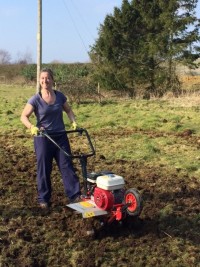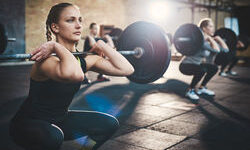Functional fitness is the latest gym buzzphrase. It focuses on building a body capable of doing real-life activities in real-life positions, not just lifting a certain amount of weight in an idealised position created by a gym machine.
Kelsey Kerridge managing director, Lianne Shadrack discovered first hand just how good functional exercise was for toning muscles and strengthening the core. A six hour stint clearing a five acre paddock was enough to reinforce the fact that moving muscles in a range of directions beats a straightforward weights workout when it comes to all over fitness.

“When you are lifting, pulling and pushing trees, posts and other heavy objects, you are moving your muscles in many different ways,” says Lianne. “It means you are doing multi-jointed, multi-muscle exercises. This type of training can make everyday activities easier as well as improving your general fitness and reducing your risk of injury. If you can incorporate functional fitness-type activities into your gym routine, you will soon start to feel the benefit.”
How do you turn your regular weights session in the gym into a functional fitness training session?
Well, some exercises are functional by their nature anyway. A squat is a functional exercise because it uses all the muscles that you call upon when you get up from a chair or pick up a low object. A bicep curl, on the other hand, is not – can you think of a time when you replicate that exact action in everyday life?
Functional fitness exercises can be done at home or at the gym. Gyms may offer functional fitness classes or incorporate functional fitness into boot camps or other types of classes. Exercise tools, such as fitness balls, kettle bells and weights, are often used in functional fitness workouts.
The difference between conventional weight training and functional fitness is that conventional weight training isolates muscle groups, but it doesn’t teach the muscle groups you’re isolating to work with others. Functional fitness teaches all the muscles to work together efficiently.
Here is an example of a functional exercise. A bent-over row, where you are leaning over a bench, holding the weight in one hand with your arm hanging straight down, and then pulling the weight up as your elbow points to the ceiling, finishing with your upper arm parallel to the ground. The exercise mainly works the back, the shoulders, the arms and the chest, but it is actually working the whole body, because the legs are taking the weight and the stomach is working hard to keep your body in position.
Compare that motion to a carpenter bending over a piece of wood, a nurse bending over a bed to transfer a patient, or a car mechanic bending over the car engine to do some work on the engine. Anyone doing a bent-over row will find there is a transferable action in things you do in normal life
Three functional exercises you can do in the gym
Power clean – lift a weights bar from the floor to your chest in one swift movement. Start with knees bent and back straight. Generate power through your legs.
This exercise is all about whole body explosiveness. As you lift the weight from the floor to your chest, you are using your ankles, calves, hamstrings, quads, hip flexors, as well as your core and arms.
2. Overhead press – left the weight bar from your chest to an overhead position, with your arms straight. The movement replicates throwing, pushing and lifting and, unlike a bench press, you are standing, which means you are pushing through your legs as well.
3. Chin-up – using a bar, hang with your arms almost straight, now pull up until your chin is over the height of the bar. In effect, you are pulling your entire body weight upwards. This sort of movement might transfer to climbing, dragging objects, wrestling.
This does not mean that conventional weight training is to be avoided. A good weight training session
will combine elements of both. By integrating functional fitness exercises into your work out, you are ensuring a full range of muscles is being worked, which will give you greater stability and fitness for everyday life.







